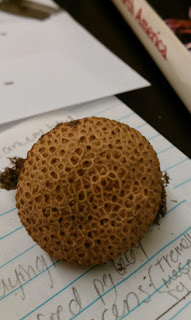Family: Sclerodermataceae
Collection Date: September 27,2011
Habitat: Growing under conifer's in a small group and also found on a decaying tree in another area
Location: James H . Barrow Field Station in Hiram, Ohio
Description: "The fruiting body is about 2-10 cm broad and about 2-6 cm high, round or somewhat flattened, the underside often with a stemlike base composed of ridges, mycelial fibers, and/or adhering debris; evntually cracking into lobes to form an irregular pore, the lobes not normally bending outward or unfolding appreciably. The peridium is hard and fairly rigid, 1-3 mm thick, white when sectioned, usually staining pinkish if fresh; the surface is yellow-brown to tan and cracked or arranged into prominent, inherent scales which often have a smaller, central wart. The spore mass is white when very young, soon gray to purple-gray with whitish veins running through it, then drak purple-gray to purple-black or black and still solid and firm; eventually becoming powdery and blackish-brown. They can be solitary, scattered, or in groups or clumps on the ground or in rotten wood. Very widespread and common. They are poisonous! Can cause nausea, vomiting, diarrhea, chills, and cold sweats" (Aurora p. 708, 1986).
Collector: Brooke Warren
Key Used: Aurora, D. (1986). Mushrooms Demystified. New York: Ten Speed Press.
Keying Steps:
Key to the Major Groups of Fleshy Fungi
1A. Spores produced on mother cells called basidia; fruiting body variously shaped (see pp. 52-54)... Basidiomycotina, p. 57
Key to the Basidiomycetes
1B. Basidia and spores borne internally (inside the fruiting body or inside a spore case or small capsules); spores not forcibly discharged, thus a spore print unobtainable Gasteromycetes, p. 676
Key to the Gasteromycetes
1B. Fruiting body differently constructed and usually larger than above... 2
2B. Not as above (but fruting body may be slimy or malodorous at some stage)... 3
3B. Stalk absent or rudimentary... 7
7A. spore case rupturing or disinteggrating at maturity; spore mass firm and solid when young (chambers present hardly discernible), powdery or cottony when mature and usually dispersing fairly soon; columella (internal stalk) typically absent; mature fruiting body usually (but not always) above ground; found in many habitats... Lycoperdales & Allies, p.677
Key to the Lycoperdales & Allies
1B. Not as above (fruiting body may rupture in starlike fashion, but if so then there is no separate spore case within)... 2
2B. Spore mass not containing peridioles, or if so then the peridioles considerably larger than grains of sand (usually aappearing more like seeds)... 4
4B. Not as above; peridioles absent; spores produced in a single large chamber (the spore case)... 5
5A. Spore case typically hard or tough with a thick rindlike skin, at least when young; spore mass white when very young but soon darkening (usually purpole-gray to black) while remaining firm, eventually becoming dark brown to blackish and powdery; basidia not borne in a hymenium; capillitium absent... Scleroderma, p. 707
Key to Scleroderma
1B. Not as above; mature spores ornamented; founnd underground or above; common... 2
2B. Not as above; fruiting above the ground, or if underground then usually with an obvious base or point of attachment; peridium not marbled in cross-section; spores borne on basidia... 3
3B. Not as above; either peridium thinner (averaging 1-4 mm) or not rupturing into starlike lobes; fruiting body fairly small to medium-sized (rarely large)... 4
4B. Not as above ("stalk" if present shorter and/or habitat different)... 5
5A. Peridium (skin) covered with prominent inherent rosette-like scales (i.e. each scale often with a central wart); widespread, but especially common in forests... 6
6B. Peridium fairly thick (usually 1-4 mm), rupturing into lobes in age or forming an irregular pore; spores reticulate... S. citrinum
 |
| Fig.1 Group of fruiting bodies that were found growing together under a tree. |
 |
| Fig. Stem-like base composed of mycelial fibers and debris |
 |
| Fig. Inside view of the mature purple-gray spore mass |
 |
| Fig. Yellow-brown colored fruiting body. The scales are a dark brown color |
http://www.norfolkwildlifetrust.org.uk/Wildlife-in-Norfolk/Species/Fungi/Common-Earthball.aspx
http://www.wsbrc.org.uk/uf6YqGEw8EW1y9cezXBvsw%3D%3D/Species.aspx
http://www.first-nature.com/fungi/scleroderma-citrinum.php
http://healing-mushrooms.net/archives/scleroderma-citrinum.html
No comments:
Post a Comment